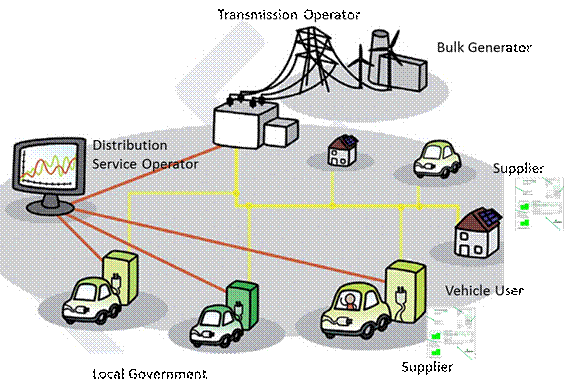Open Platform 3.0™ Snapshot – Example of a Wider Business Ecosystem
Use-case 15 in the Nexus of Forces in Action White Paper [Nexus] provides a good example of a wider business ecosystem. It concerns smart charging of electric vehicles. The participants include:
- Bulk energy generators
- (National) grid operators (transmission operators)
- Local supply network operator (distribution service operator or DSO)
- Energy suppliers (i.e., the parties who have a contractual relationship with the energy consumer – these may also be bulk generators)
- Consumers (vehicle users)
- Local government

Electric Vehicle Smart Charging Ecosystem
A Vehicle User can charge a vehicle at a public charging station or via a private power supply (home or office). This use-case is only concerned with the former situation but could be extended to cover both scenarios.
A local controller (a device – part of the Internet of Things) controls one or more charging stations. The Energy Supplier informs the vehicle (and possibly the Vehicle User) via the local controller how much capacity is available to it. If the battery is nearly full the vehicle can inform the local controller that it needs less capacity and this capacity can then be made available to other vehicles at other charging stations. Standard protocols are defined, which can be used to support end-to-end communication.
The Charging Operator determines the capacity to be made available on the basis of information provided by the Distribution Service Operator (DSO) (maximum allowable capacity at that time), possibly combined with commercial information (e.g., current spot prices, predicted trends, flexibility agreements with vehicle-owners/customers where applicable). The DSO has predicted available capacity on the basis of currently predicted weather conditions and long-term usage patterns in the relevant area. The DSO is able to adapt to unexpected changes in real time and restrict or increase the locally available capacity.
We can regard the purpose of this ecosystem as providing a sustainable infrastructure for the use and support of electric vehicles. If we speak of the health of the system as a whole, this is how we will measure it. Each participant has to a greater or lesser extent an interest in the health of the system. Nonetheless the individual participants have varying measures of value and varying degrees of commitment to or dependence on the system as a whole.